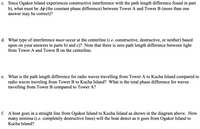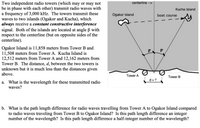Question
Please provide equations used - do not just input numbers! Thanks.
All questions refer to first figure.

Transcribed Image Text:c. Since Ogakor Island experiences constructive interference with the path length difference found in part
b), what must be Aø (the constant phase difference) between Tower A and Tower B (more than one
answer may be correct)?
d. What type of interference must occur at the centerline (i.e. constructive, destructive, or neither) based
upon on your answers to parts b) and c)? Note that there is zero path length difference between light
from Tower A and Tower B on the centerline.
e. What is the path length difference for radio waves travelling from Tower A to Kucha Island compared to
radio waves traveling from Tower B to Kucha Island? What is the total phase difference for waves
travelling from Tower B compared to Tower A?
f. A boat goes in a straight line from Ogakor Island to Kucha Island as shown in the diagram above. How
many minima (i.e. completely destructive lines) will the boat detect as it goes from Ogakor Island to
Kucha Island?

Transcribed Image Text:Two independent radio towers (which may or may not
be in phase with each other) transmit radio waves with
a frequency of 3,000 kHz. The towers transmit these
waves to two islands (Ogakor and Kucha), which
always receive a constant constructive interference
signal. Both of the islands are located at angle ß with
respect to the centerline (but on opposite sides of the
centerline).
centerline -->
Kucha Island
Ogakor Island
boat course
Ogakor Island is 11,858 meters from Tower B and
11,508 meters from Tower A. Kucha Island is
12,512 meters from Tower A and 12,162 meters from
Tower B. The distance, d, between the two towers is
unknown but it is much less than the distances given
above.
Tower A
Tower B
d = ?
What is the wavelength for these transmitted radio
waves?
а.
b. What is the path length difference for radio waves travelling from Tower A to Ogakor Island compared
to radio waves traveling from Tower B to Ogakor Island? Is this path length difference an integer
number of the wavelength? Is this path length difference a half-integer number of the wavelength?
Expert Solution
This question has been solved!
Explore an expertly crafted, step-by-step solution for a thorough understanding of key concepts.
This is a popular solution
Trending nowThis is a popular solution!
Step by stepSolved in 3 steps with 3 images

Knowledge Booster
Similar questions
- A large sheet of construction paper measures 20mm by 15mmand the volume is 4mm³, where v=lwt A. What is the thickness(t) of the paper in mm? B. What is the thickness of the paper in micrometers? (Ųm)arrow_forwardFor each biological model below determine the dimensions of the parameters, based on the given dimensions of the variables. 1. Model of number of mutations M as a function of time t: M(t) — Мо + дut 2. Model of molecular concentration C as a function of time t: -kt C(t) = Coe 3. Model of tree height H (length) as a function of age a (time): ba H(a) c+a 4. Model of cooperative binding of ligands, with fraction of bound receptors 0 as a function of ligand concentration L: 0(L) = Ln + Kd 5. Model of concentration of a gene product G (concentration) as a function of time t: G(t) = Gm(1 – e at)arrow_forwardA spelunker is surveying a cave. She follows a passage 160 m straight west, then 230 m in a direction 45 degree east of south, and then 280 mm at 30 degree east of north. After a fourth unmeasured displacement, she finds herself back where she started. Part a)Use a scale drawing to determine the magnitude of the fourth displacement. Express your answer using two significant figures. Part B)Determine the direction of the fourth displacement. Express your answer using two significant figuresarrow_forward
- Answer must be in standard form scientific notation with SI it’s that do not have prefixes. Also correct number of sig. fig.arrow_forwardShow solutions. 2. The following lengths are given in meters. Use metric prefixes to rewrite them so the numerical value is bigger than one but less than 1000. For example, 7.9x10-2m could be written either as 7.9 cm or 79 mm. (a) 7.59x107m; (b) 0.0074 m; (c) 8.8x10-11m; (d) 1.63×1013m.arrow_forwardStarting with the definition that 1.00 in. = 2.54 cm, find the number of kilometers in 3.107 miles, and the number of feet in 1.00 km.arrow_forward
- Mary is training for a marathon where she needs to run 13,120m, but she needs to know how many miles that is for her training program, How many miles (rounded to the nearest ones place) will Mary be running for the race? 1m = 3.28ft, 5280ft = 1 mile. Please perform dimensional analysis and show the conversion between all unit factors to find the solution." Please format the two factors as fractions, using the math equation formatting "square root" tool. And then state the final answer.arrow_forward1.3 The Role of Units in Problem Solving A particular convenience store offers a drink called the "MegaGulp". If the cup holds 107 fl oz. of liquid and we treat the "Mega" in the name as a metric prefix, how many mL are in a "Gulp"? O 0.000107 O 0.000000362 O 316000000 O 0.00317 Save for Later Submit Answerarrow_forwardBelow is the calculator result for the operation indicated. Enter the answer to the correct number of significant figures for this calculation, using the rules for significant figures. 2.15648 0.0056892 = 2.1507908arrow_forward
arrow_back_ios
SEE MORE QUESTIONS
arrow_forward_ios